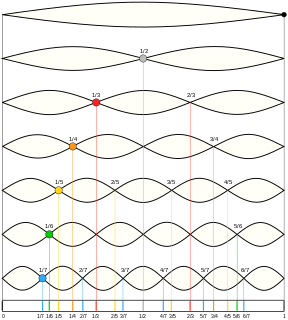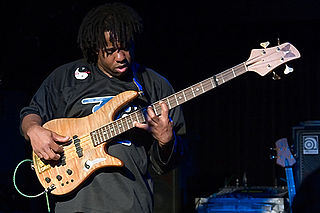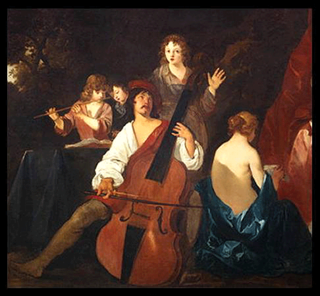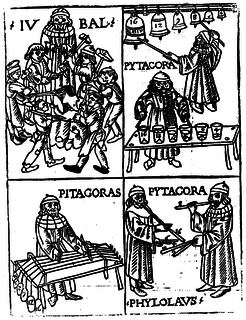
Bass ( BAYSS) describes tones of low (also called "deep") frequency, pitch and range from 16 to 256 Hz (C0 to middle C4) and bass instruments that produce tones in the low-pitched range C2-C4. They belong to different families of instruments and can cover a wide range of musical roles. Since producing low pitches usually requires a long air column or string, and for stringed instruments, a large hollow body, the string and wind bass instruments are usually the largest instruments in their families or instrument classes.

The Classical period was an era of classical music between roughly 1730 and 1820.

A harmonic is any member of the harmonic series. The term is employed in various disciplines, including music, physics, acoustics, electronic power transmission, radio technology, and other fields. It is typically applied to repeating signals, such as sinusoidal waves. A harmonic of such a wave is a wave with a frequency that is a positive integer multiple of the frequency of the original wave, known as the fundamental frequency. The original wave is also called the 1st harmonic, the following harmonics are known as higher harmonics. As all harmonics are periodic at the fundamental frequency, the sum of harmonics is also periodic at that frequency. For example, if the fundamental frequency is 50 Hz, a common AC power supply frequency, the frequencies of the first three higher harmonics are 100 Hz, 150 Hz, 200 Hz and any addition of waves with these frequencies is periodic at 50 Hz.
An nth characteristic mode, for n > 1, will have nodes that are not vibrating. For example, the 3rd characteristic mode will have nodes at L and L, where L is the length of the string. In fact, each nth characteristic mode, for n not a multiple of 3, will not have nodes at these points. These other characteristic modes will be vibrating at the positions L and L. If the player gently touches one of these positions, then these other characteristic modes will be suppressed. The tonal harmonics from these other characteristic modes will then also be suppressed. Consequently, the tonal harmonics from the nth characteristic modes, where n is a multiple of 3, will be made relatively more prominent.

An overtone is any frequency greater than the fundamental frequency of a sound. Using the model of Fourier analysis, the fundamental and the overtones together are called partials. Harmonics, or more precisely, harmonic partials, are partials whose frequencies are numerical integer multiples of the fundamental. These overlapping terms are variously used when discussing the acoustic behavior of musical instruments. The model of Fourier analysis provides for the inclusion of inharmonic partials, which are partials whose frequencies are not whole-number ratios of the fundamental.

String instruments, stringed instruments, or chordophones are musical instruments that produce sound from vibrating strings when the performer plays or sounds the strings in some manner.

A transposing instrument is a musical instrument whose music is recorded in staff notation at a pitch different from the pitch that actually sounds. A written middle C on a transposing instrument produces a pitch other than middle C, and that pitch identifies the interval of transposition when describing the instrument. For example, a written C on a B♭ clarinet sounds a concert B♭.

In music, timbre is the perceived sound quality of a musical note, sound or tone. Timbre distinguishes different types of sound production, such as choir voices and musical instruments, such as string instruments, wind instruments, and percussion instruments. It also enables listeners to distinguish different instruments in the same category.

An electronic keyboard or digital keyboard is an electronic musical instrument, an electronic or digital derivative of keyboard instruments. Broadly speaking, the term electronic keyboard or just a keyboard can refer to any type of digital or electronic keyboard instrument. These include synthesizers, digital pianos, stage pianos, electronic organs and digital audio workstations. However, an electronic keyboard is more specifically a synthesizer with a built-in low-wattage power amplifier and small loudspeakers.
This is a list of musical terms that are likely to be encountered in printed scores, music reviews, and program notes. Most of the terms are Italian, in accordance with the Italian origins of many European musical conventions. Sometimes, the special musical meanings of these phrases differ from the original or current Italian meanings. Most of the other terms are taken from French and German, indicated by "Fr." and "Ger.", respectively.

In music, unison is two or more musical parts sounding the same pitch or at an octave interval, usually at the same time.

A bassline is the term used in many styles of music, such as jazz, blues, funk, dub and electronic, traditional music, or classical music for the low-pitched instrumental part or line played by a rhythm section instrument such as the electric bass, double bass, cello, tuba or keyboard. In unaccompanied solo performance, basslines may simply be played in the lower register of any instrument such as guitar or piano while melody and/or further accompaniment is provided in the middle or upper register. In solo music for piano and pipe organ, these instruments have an excellent lower register that can be used to play a deep bassline. On organs, the bass line is typically played using the pedal keyboard and massive 16' and 32' bass pipes.

The kaval is a chromatic end-blown flute traditionally played throughout Armenia, the Balkans and Turkey. The kaval is primarily associated with mountain shepherds.
In music, a register is the "height" or range of a note, set of pitches or pitch classes, melody, part, instrument, or group of instruments. A higher register indicates higher pitch.

A quarter tone is a pitch halfway between the usual notes of a chromatic scale or an interval about half as wide as a semitone, which itself is half a whole tone.
Keyboard expression is the ability of a keyboard musical instrument to respond to change tone or other qualities of the sound in response to velocity, pressure or other variations in how the performer depresses the keys of the musical keyboard. Expression types include:

The term violone can refer to several distinct large, bowed musical instruments which belong to either the viol or violin family. The violone is sometimes a fretted instrument, and may have six, five, four, or even only three strings. The violone is also not always a contrabass instrument. In modern parlance, one usually tries to clarify the 'type' of violone by adding a qualifier based on the tuning or on geography, or by using other terms that have a more precise connotation. The term violone may be used correctly to describe many different instruments, yet distinguishing among these types can be difficult, especially for those not familiar with the historical instruments of the viol and violin families and their respective variations in tuning.

In musical tuning, a temperament is a tuning system that slightly compromises the pure intervals of just intonation to meet other requirements. Most modern Western musical instruments are tuned in the equal temperament system. "Tempering is the process of altering the size of an interval by making it narrower or wider than pure. A temperament is any plan that describes the adjustments to the sizes of some or all of the twelve fifth intervals in the circle of fifths so that they accommodate pure octaves and produce certain sizes of major thirds." Temperament is especially important for keyboard instruments, which typically allow a player to play only the pitches assigned to the various keys, and lack any way to alter pitch of a note in performance. Historically, the use of just intonation, Pythagorean tuning and meantone temperament meant that such instruments could sound "in tune" in one key, or some keys, but would then have more dissonance in other keys.

Diatonic and chromatic are terms in music theory that are most often used to characterize scales, and are also applied to musical instruments, intervals, chords, notes, musical styles, and kinds of harmony. They are very often used as a pair, especially when applied to contrasting features of the common practice music of the period 1600–1900.
This is a list of jazz and popular music terms that are likely to be encountered in printed popular music songbooks, fake books and vocal scores, big band scores, jazz, and rock concert reviews, and album liner notes. This glossary includes terms for musical instruments, playing or singing techniques, amplifiers, effects units, sound reinforcement equipment, and recording gear and techniques which are widely used in jazz and popular music. Most of the terms are in English, but in some cases, terms from other languages are encountered.





















